Chippewa Square (Savannah, Georgia)
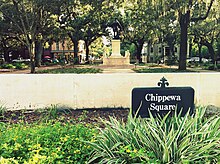 The south-facing James Oglethorpe Monument, viewed from where the bench in Forrest Gump was located for its 1993 filming | |||
| Namesake | Battle of Chippawa | ||
|---|---|---|---|
| Maintained by | City of Savannah | ||
| Location | Savannah, Georgia, U.S. | ||
| Coordinates | 32°04′33″N 81°05′35″W / 32.0758°N 81.0931°WCoordinates: 32°04′33″N 81°05′35″W / 32.0758°N 81.0931°W | ||
| North | Bull Street | ||
| East | East McDonough Street | ||
| South | Bull Street | ||
| West | West McDonough Street | ||
| Construction | |||
| Completion | 1815 | ||
Chippewa Square is one of the 22 squares of Savannah, Georgia, United States. It is located in the third row of the city's five rows of squares, on Bull Street and McDonough Street, and was laid out in 1815. It is south of Wright Square, west of Colonial Park Cemetery, north of Madison Square and east of Orleans Square. The oldest building on the square is The Savannah Theatre, at 222 Bull Street, which dates to 1818.
The square named in honor of American soldiers killed in the Battle of Chippawa during the War of 1812. (The spelling "Chippewa" is correct in reference to this square.)
In the center of the square is the James Oglethorpe Monument, created by sculptor Daniel Chester French and architect Henry Bacon and unveiled in 1910.[1] Oglethorpe faces south, toward Georgia's one-time enemy in Spanish Florida, and his sword is drawn.[2] Busts of Confederate figures Francis Stebbins Bartow and Lafayette McLaws were moved from Chippewa Square to Forsyth Park to make room for the Oglethorpe monument.[3] Due to the location of the monument, Savannahians sometimes refer to this as Oglethorpe Square, although Oglethorpe Square sits just to the northeast.[4]
The "park bench" scene which opens the 1994 film Forrest Gump was filmed on the north side of Chippewa Square.[5] The bench was a fiberglass prop, rather than one of the park's actual benches.[1] A replica of the prop bench used in the film is on display at the Savannah Visitors Center. The original prop is now is kept in Paramount Studios, Los Angeles.[6]
Chippewa Square is also home to the First Baptist Church (1833),[7] the Independent Presbyterian Church and the Philbrick–Eastman House (1847).[8]
Dedication[]

The square is named for the Battle of Chippawa, a conflict during the War of 1812
Markers and structures[]

James Oglethorpe Monument in the center of the square

Historical marker

Marker (1815)
Constituent buildings[]
Each building below is in one of the eight blocks around the square composed of four residential "tything" blocks and four civic ("trust") blocks, now known as the Oglethorpe Plan. They are listed with construction years where known.
- Northwestern residential/tything block
- Independent Presbyterian Church, 207 Bull Street (1891) – by John Holden Greene; gutted in the 1889 fire, rebuilt 1891
- Independent Presbyterian Church School Building, 207 Bull Street (1894) – by Charles Henry
- Honora Foley Property, 14 West Hull Street (1896) – by Henry Urban; also known as the Foley House Inn
- Julius Perlinski House, 22 West Hull Street (c. 1903)
- Northwestern civic/trust block
- First Baptist Church, 223 Bull Street (1833)
- Southwestern civic/trust block
- Philbrick–Eastman House, 17 West McDonough Street (1847)[9]
- Southwestern residential/tything block
- 3 West Perry Street (1831)[10]
- John Stoddard House, 15 West Perry Street (1867)[10]
- Stoddard Row, 19–25 West Perry Street (1854–55)
- 233 Bull Street (1842) – originally the home of Moses Eastman, later of the Philbrick–Eastman House[11]
- Northeastern residential/tything block
- Board of Education Building, 208 Bull Street (1908–1910)
- Northeastern civic/trust block
- The Savannah Theatre, 222 Bull Street (1818) – oldest building on the square
- Southeastern civic/trust block
- Julius Koox Duplex, 230–232 Bull Street (1871)
- Southeastern residential/tything block
- 234 Bull Street (c. 1900)
- Hetty, Abbie & Phillipa Minis House, 11 East Perry Street (c. 1820)
Gallery[]
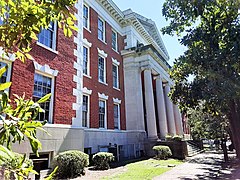
Board of Education Building, 208 Bull Street

The Savannah Theatre, 222 Bull Street
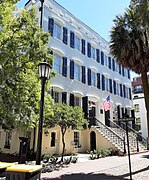
Julius Koox Duplex, 230–232 Bull Street

234 Bull Street

Hetty, Abbie & Phillipa Minis House, 11 East Perry Street
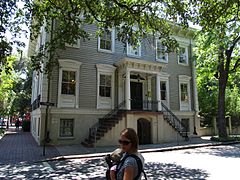
3 West Perry Street

John Stoddard House, 15 West Perry Street

Stoddard Row, 19–25 West Perry Street
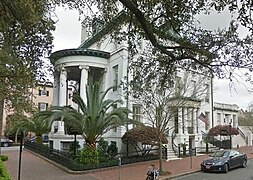
Philbrick–Eastman House, 17 West McDonough Street
First Baptist Church, 223 Bull Street

Foley House Inn, 14 West Hull Street

Julius Perlinski House, 22 West Hull Street

Independent Presbyterian Church, 207 Bull Street

Independent Presbyterian Church School Building, 207 Bull Street
References[]
- ^ a b Tour Guide Manual for licensed tour guides in the City of Savannah, accessed June 16, 2007.
- ^ Our Coast's guide to Savannah's Squares, accessed June 16, 2007. Site features an excellent interactive map of Savannah's squares and numerous photographs.
- ^ City of Savannah's monuments page This page links directly to numerous short entries, many accompanied by photographs, discussing a variety of monuments, memorials, etc., in the squares and elsewhere. Accessed June 16, 2007.
- ^ Chan Sieg (1984). The squares: an introduction to Savannah. Virginia Beach: Donning.
- ^ Savannah Scene magazine, May–June 2007, pp 10–11, accessed June 16, 2007.
- ^ "Forrest Gump, Savannah: Bench & Filming Locations". gosouthsavannah.com. Retrieved April 12, 2021.
- ^ Barry Sheehy; Cindy Wallace (1 February 2011). Savannah, Immortal City. Greenleaf Book Group. pp. 216–. ISBN 978-1-934572-70-2. Retrieved August 17, 2013.
- ^ Whip Morrison Triplett (2006). Savannah. Arcadia Publishing. pp. 38–. ISBN 978-0-7385-4209-6. Retrieved August 17, 2013.
- ^ Philbrick-Eastman House – The Georgia Trust for Historic Preservation
- ^ a b Historic Building Map: Savannah Historic District – Historic Preservation Department of the Chatham County-Savannah Metropolitan Planning Commission (November 17, 2011), p. 38
- ^ Brown Ward – City of Savannah research paper
- Chippewa Square, Savannah
- 1815 establishments in Georgia (U.S. state)


















